XRP futures are finally live on CME. It’s a big moment; not just for Ripple loyalists, but for anyone tracking how institutional money moves in crypto. If you’re wondering how to trade XRP futures now that they’re on the big board, or what this means for the token’s future, you’re in the right place. Here’s what you need to know.
KEY TAKEAWAYS
➤ XRP futures are now live on CME, offering regulated, cash-settled exposure for institutional traders.
➤ Retail traders can also access XRP futures on platforms like OKX, KuCoin, and Bitget, but with higher leverage and risk.
➤ This launch could shape XRP’s future price, open the door to a spot ETF, and shift how seriously the market treats the token.
How to trade XRP futures
Trading XRP futures isn’t complicated, but it does require a few key steps. Whether you’re hedging exposure or testing momentum trades, here’s how to get started.
In short, you must:
• Choose a broker that offers CME access
• Pick your contract type
• Fund your account with sufficient margin
• Place a long or short position
• Track expiry, reference rates, and manage risk
Here’s each step in detail.
Step 1: Choose a broker that offers CME access
You’ll need a trading platform that lets you access CME’s derivatives. Most retail traders use brokers like Interactive Brokers or TD Ameritrade. Institutional desks typically go through clearing members or Prime Brokers. Make sure you’re approved for futures trading before anything else.
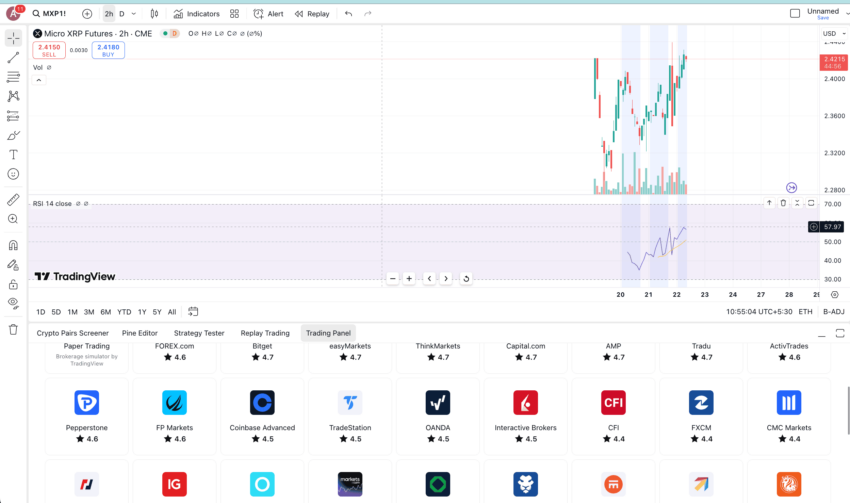
Once inside, you might need to activate certain permissions to be able to trade futures. But then, the permissions are completely broker-specific.
Step 2: Pick your contract type
CME offers two XRP futures contracts:
- Standard: 50,000 XRP
- Micro: 2,500 XRP
Both are cash-settled in USD, based on the CME CF XRP-Dollar Reference Rate, which updates daily at 4pm London time. No tokens are moved. You’re just trading on price.

Did you know? The micro contracts (2,500 XRP) are built for smaller traders or those testing positions without going all-in. They involve the same exposure logic and require lower capital commitment. Institutions usually prefer the 50K standard contracts, but both settle the same way: in cash.
Step 3: Fund your account with sufficient margin
These aren’t spot trades. So, you’ll need to meet CME’s margin requirements, which vary daily. For a 50,000 XRP contract, expect a margin requirement in the $6,000–$8,000 range, depending on volatility. Your broker will specify the exact figure.
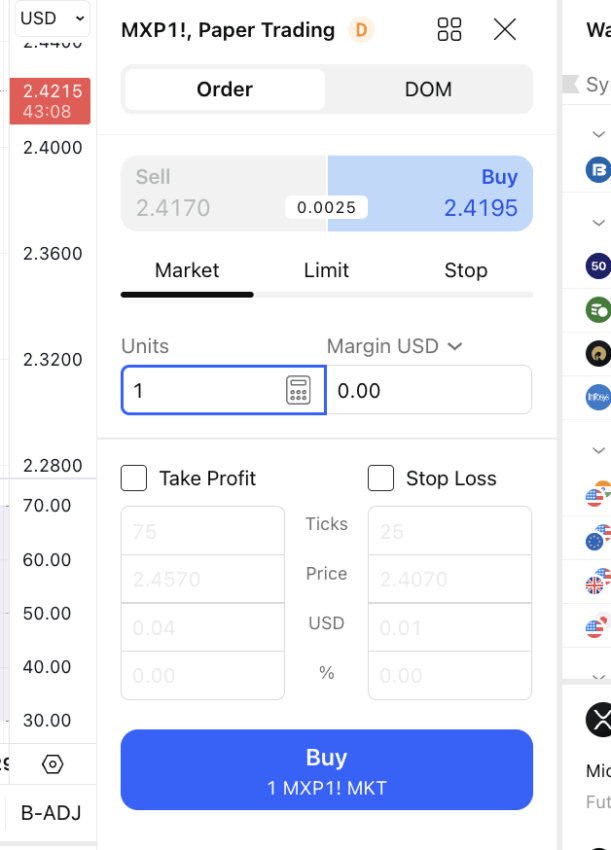
Quick tip: If you are tracking the price of XRP futures, XRP, or MXP (Micro XRP) using TradingView, you can directly place a trade from the interface by selecting and logging into the broker of choice, provided you already have an account.
Step 4: Place a long or short position
Bullish on XRP? Go long. Bearish? Go short. Futures let you express either view. Use market or limit orders, and watch the contract month you’re trading (May, June, etc.). You don’t need to hold till expiry, you can close anytime.
Step 5: Track expiry, reference rates, and manage risk
XRP futures settle daily at 4pm GMT, based on a calculated reference price. Always check when your contract expires. Because you’re trading with leverage, risk management isn’t optional; stop losses and tight sizing are key.

You can also trade XRP futures as part of the exchange-specific derivatives suite. Here are the steps for that:
Step 1: Create an account on a crypto exchange
Pick a platform that supports XRP futures. OKX, KuCoin, Bitget, Binance, and MEXC are popular. Sign up and complete KYC if required.
Step 2: Deposit USDT or crypto
You’ll need to fund your account with USDT, USDC, or another coin supported as margin for futures trading.
Step 3:Navigate to the XRP perpetual or futures tab
Go to the derivatives section of the exchange. Select XRP/USDT perpetual or a dated contract, depending on what’s available.
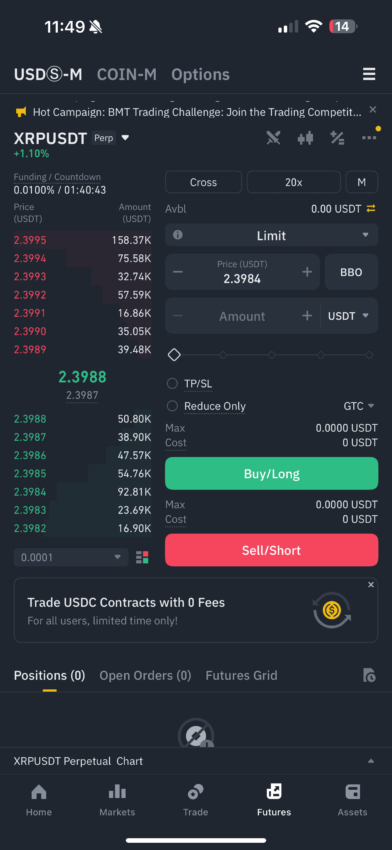
Step 4: Choose your leverage and position size
Decide how much leverage you want to use (2x to 50x+ is typical). Adjust size based on your risk tolerance.
Step 5: Place your order (long or short)
Use a limit or market order to go long (price up) or short (price down). Double-check your liquidation price before confirming.
Step 6: Manage your open position
Track funding rates, PnL, and price movements. Close your position manually or use take-profit/stop-loss orders to exit.
What are CME XRP futures?
CME XRP futures are contracts that let you bet on XRP’s price movement, without owning the token. You’re trading on direction, not custody. Thanks to CME, that now happens inside a regulated, cash-settled environment.
How do CME XRP futures work?
With XME XRP futures, you’re not buying XRP or sending it to a wallet. You’re simply opening a position that tracks XRP’s price based on the CME CF XRP-Dollar Reference Rate.
At the end of the contract, you either make money or lose money based on the difference between your entry and the final settlement price. No XRP ever moves. It’s all in USD.
This kind of product is common in crypto futures trading, and now, for the first time, XRP joins Bitcoin and Ethereum on that institutional level.
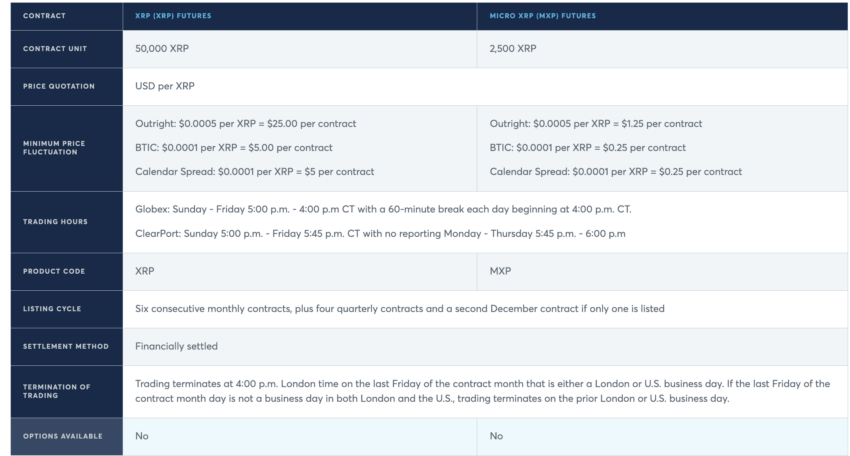
Where can you trade CME XRP futures?
To trade XRP futures on CME, you’ll need a broker that offers access to CME’s Globex platform. These are typically traditional brokers that also support derivatives trading.
Brokers that list CME XRP contracts include:
- Interactive Brokers
- TD Ameritrade
- E*TRADE
- Charles Schwab (via futures-enabled accounts)
There are many other platforms that support trading of CME XRP futures. You can find the entire list on TradingView’s asset-specific panel.
If you’re not using a traditional broker, some crypto-native platforms already offer XRP perpetual futures and contracts with leverage. These include:
- OKX
- KuCoin
- Bitget
- Binance
These aren’t the CME contracts, but they function similarly in terms of directional trading and leverage. The key difference is regulation and how margin is handled.
Did you know? CME contracts settle in cash. That makes them different from perps on crypto exchanges, which are usually backed by collateral in USDT or another coin. If you’re trading through CME, you’re working with USD-based P&L only.
Why this launch matters for XRP
Now that you know how XRP futures work, next up is what they actually mean for traders, investors, and XRP’s future price behavior.
The launch of XRP futures on CME isn’t just about more trading tools; it’s about legitimacy. Futures trading is a prerequisite, historically, for any crypto ETF approval. Now that XRP has CME-listed contracts, the narrative shifts. ETF conversations aren’t hypothetical anymore.
CME didn’t list XRP futures to be trendy. It did it because there’s actual demand. For a token that’s spent years stuck in regulatory limbo, getting a formal futures contract on the world’s biggest derivatives exchange is more than just a headline. It’s a shift in who’s allowed to care about XRP again.
Here’s what’s actually going on.
Institutional traders finally have a green light
Before May 2025, if a fund wanted exposure to XRP, they had to hold the token outright or mess around with unregulated platforms. Now they can trade cash-settled XRP futures on CME, just like BTC and ETH.
This gives asset managers, hedge funds, and algo desks real entry points. Not with trial accounts and MetaMask extensions, but through Bloomberg terminals and regulated brokers. That alone changes who gets to play.
XRP just unlocked the ETF path
Historically, the SEC hasn’t approved spot crypto ETFs unless there’s a corresponding regulated futures market. That’s why ETH got its ETF momentum after its CME futures launched. Now XRP fits the same mold.
If volumes stay consistent and price manipulation stays low, the “we don’t have a mature market” argument from regulators starts to break.
This doesn’t mean an XRP spot ETF is guaranteed — just that there’s no structural reason left to block it.
And that’s a key step, because futures aren’t just another trading product; they serve as a compliance anchor. Derivatives Trader, Gordon Grant, explained exclusively to BeInCrypto how regulated futures markets help build the framework ETF approvals need:
“A commodity contract on a cryptocurrency may establish a relevant regulated market for observation and oversight in a way that might not exist otherwise, given that the spot market is not directly regulated in the same way as other commodity foreign exchange or securities markets are.”
In short, the existence of a regulated futures market is a key step that offers the oversight needed for an eventual ETF approval.
Liquidity = confidence = volume
With CME involved, XRP gets cleaner price discovery. The contracts are large enough (50K XRP standard, 2.5K XRP micro) to bring in big players, and that means more volume, more liquidity, tighter spreads, and fewer weird price wicks from low-cap exchanges.
Even if you never touch futures, your spot XRP bags could benefit from better institutional anchoring.
Market narrative has shifted again
There was a time when XRP was the black sheep of crypto — delisted, de-platformed, dismissed as “the bank coin.” However, in 2025, is seems that phase is behind us. With futures live, trading volume spiking, and ETFs now in view, XRP’s positioning is getting a rewrite.
The new pitch? Regulated exposure to a fast-settlement layer that’s not Ethereum. That plays well in TradFi.
So, how clean is this flow?
CME futures are cash-settled, which is safer, but it also opens the door to passive speculation without impact on the underlying spot price. If too much activity sits in futures, without enough carryover to spot, the market impact becomes muted.
So while the launch is great for signaling, real accumulation still needs to come from demand outside the futures loop. Keep an eye on spot inflows, not just open interest.
What to know before you trade CME XRP futures
XRP futures aren’t for everyone, and just because they’re listed on CME doesn’t mean they’re risk-free. Here’s what to check off before placing your first trade:
1. You’ll need serious capital
Even micro contracts (2,500 XRP) can demand over $1,000 in margin. Standard contracts are easily north of $6,000. This isn’t the kind of trade you sneak in with pocket change.
2. It’s cash-settled; no token involved
You won’t touch XRP. You won’t get XRP. If your thesis depends on owning the asset or staking it, futures won’t work for you. These are price bets, not token plays.
3. Volatility works both ways
XRP moves fast; sometimes, too fast. With leverage involved, you could lose your margin in minutes if the trade swings. Futures amplify both wins and wipeouts.
Volatility remains one of the biggest unknowns in the XRP trade, especially when it comes to derivatives trading. Gordon Grant laid out the variables traders should study before jumping in:
“It may be useful to examine relevant features of the putative XRP futures market such as spreads, volumes, open interest and order book depth as well as various measures of volatility in order to assess the relative characteristics of this market as it comes into existence.”
4. Not all brokers are equal
Accessing CME XRP contracts means using platforms like Interactive Brokers or TD Ameritrade. If you’re on a Binance or Coinbase-style platform, you’re not trading the real deal.
5. It’s mostly institutional (for now)
Day-one volume was $19 million, but 90% of that came from desks, not retail traders. Expect tighter spreads, better pricing, and smarter competition.
Do XRP futures actually move XRP’s price?
XRP don’t directly change XRP’s price, but they can certainly influence it.
CME’s XRP futures are cash-settled. That means no XRP is bought or sold during the trade — just USD contracts settled based on price references. So unlike spot markets, futures trades don’t require actual XRP to change hands.
But if a lot of money flows into futures, does is indirectly affects the real price. Here’s how:
High futures volume boosts price discovery
When futures markets are deep and liquid, they create cleaner, more trusted price signals. Spot markets often adjust to align with futures, especially when institutional capital is leading the action.
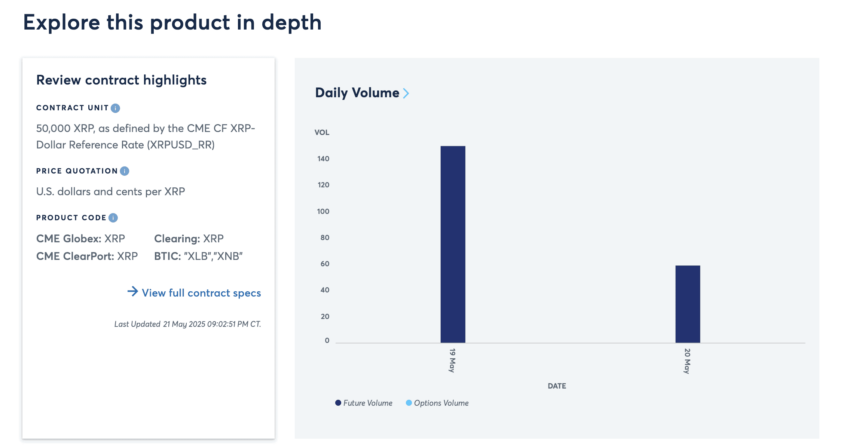
Traders hedge both sides
If a fund opens a large long futures position, it might hedge by buying spot XRP. That real buying pressure does move markets. This link is especially strong when arbitrage opportunities appear.
Market sentiment often follows CME flows
CME is considered a signal of “smart money.” If big futures positioning turns bullish, it can lead retail traders on spot exchanges to follow, creating self-fulfilling price momentum.
So while XRP futures alone don’t push XRP upward, they shape the environment in which price decisions are made, and that’s arguably just as powerful.
And in the long term, the real value of CME XRP futures might lie in how they close the gap between XRP and the market structure BTC and ETH already enjoy. Grant breaks this down further:
“XRP… has been less successful in developing what one would think of as institutional derivatives market liquidity to the same extent that BTC, ETH, and to a lesser degree SOL have… Listing of cash margined XRP futures on a regulated venue like CME could help XRP become more accessible to institutional players… engendering a market which is more consistently well behaved… in terms of volatility.”
How bullish is CME XRP futures for the native crypto?
XRP futures on CME won’t magically send prices to the moon, but they will show where the smart money’s aiming. If you’re trading them, you’re no longer just reacting to headlines. You’re placing bets on what XRP could actually become. It’s not about chasing pumps. It’s about reading the board, and possible finally, playing the long game.
Disclaimer: This article is for informational purposes only and should not be considered financial advice. Always do your own research (DYOR) and never invest more than you can afford to lose.
Frequently asked questions
Can I hold CME XRP futures overnight or over weeks?
Do I need to own XRP to trade its futures?
Will the launch of XRP futures reduce XRP’s volatility?
Can XRP futures be used to hedge actual XRP holdings?
Disclaimer
In line with the Trust Project guidelines, the educational content on this website is offered in good faith and for general information purposes only. BeInCrypto prioritizes providing high-quality information, taking the time to research and create informative content for readers. While partners may reward the company with commissions for placements in articles, these commissions do not influence the unbiased, honest, and helpful content creation process. Any action taken by the reader based on this information is strictly at their own risk. Please note that our Terms and Conditions, Privacy Policy, and Disclaimers have been updated.





